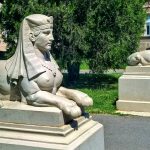The largest and most-visited camping fair in the Netherlands was held from 17 to 22 January 2019. One of the more than 400 exhibitors was the Slavonian tourism cluster, which brings together five county tourist boards from the eastern Croatia (Brod-Posavina, Osijek-Baranja, Požega-Slavonia, Virovitica-Podravina and Vukovar-Srijem counties), in cooperation with the Croatian National Tourist Board (HTZ).
Leeuwarden (West Frisian: Ljouwert) is a town in the north of the Netherlands, and it is the capital of the province of Friesland. In 2018, it was the European Capital of Culture. It is also known as the birthplace of Mata Hari (Margaretha Geertruida Zelle).
The Netherlands is known as a camping nation, and Caravana was a great venue to represent four Slavonian camps. These were two camps from Požega-Slavonia County (the Zlatni Lug camp located in the Požega suburb of Emovački Lug, and the Duboka camp located in Velika in the Papuk Nature Park), and the Familiy camp in Kopačevo and the Suza Baranje cyclo-tourist camp in Suza.
At the HTZ stand, the Slavonian cluster was represented together with the Camping Association of Croatia, the Rovinj naturist camp Valalta, and the Hadria company, headquartered in Novalja on the island of Pag.
In addition to the camps themselves, the entire tourist offer of Slavonia is presented. The Papuk Nature Park, with the Duboka campsite located at its southern edge, attracted the attention especially thanks to its protected areas, such as the Jankovac Forest Park, the Rupnica geological nature monument, and the Old Oaks special forest preservation area, and with the cultural-historical heritage (the medieval Velički-Grad, the Ružica-Grad and Kamengrad), as well as with tourist facilities (cycling trails, the Orahovica Lake recreational area, the Sokoline sports climbing facility).
The visitors were also introduced to the Kopački Rit Nature Park, as a sizeable inner delta of the Danube river and part of the “European Amazon”, with its unique biodiversity, including more than 300 species of birds, making it an ideal destination for birdwatching.
The Virovitica-Podravina County was presented as an area of Slavonia with part of the Mura-Drava Regional Park and the Papuk Nature Park. In-between these two protected natural areas, there is a vast plain ideal for cyclo-tourism. The “Drava Story” information and education centre in Noskovačka Dubrava is the starting point for exploring the Mura-Drava Regional Park, while the Jankovac Forest Park and the near-by mountain shelter serve the same function for the Papuk Nature Park. Thanks to the renovation projects of the Janković palace in Lukač and castles in Virovitica and Suhopolje, the county is becoming an exciting destination for cultural tourism as well.
Požega-Slavonia County, which includes the Golden Valley and the mountain peaks surrounding it, was presented as “Golden Slavonia”, and the attention of visitors was especially drawn to the fact that the wine industry in this area exists since at least 1232, when a wine cellar and the Valis Honesta de Gotho abbey in Kutjevo were first mentioned. Special attention was paid to the Flavours of Golden Slavonia brochure, featuring the restaurants Čiča Mata from Velika, Schön Blick from Vetovo, Stari Fenjeri from Turnić, Zlatni Lug from Donji Emovci and Grgin Dol from Požega, as well as traditional dishes such as the vineyard kebab, fish goulash, “čobanac”, carp on a fork…
Brod-Posavina County was presented as a border area that for centuries defended Europe from the Ottoman Empire, as testified by the Brod fortress. This county includes fascinating natural heritage, such as the Pljuskare canyon and Ljeskove Vode, as well as cultural heritage such as the eco-ethno village of Stara Kapela and the above-mentioned fortress in Slavonski Brod.
Vukovar-Srijem County was presented through stories about the Vučedol culture, the oldest European calendar – the Orion – found in Vinkovci, and Ilok – the land of wine and antiquities.
Osijek-Baranja County, given its four wine areas (Baranja, Erdut, Feričanci, Đakovo) and the fact that two EuroVelo corridors meet in the Baranja village of Draž, was presented as an excellent wine-and-dine and cyclo-touristic destination. The town of Osijek is the urban centre of Slavonia, confirmed by events such as the Pannonian Challenge, and it is the centre of the wine rectangular, and at the same time the town with the longest beer-making tradition in Croatia.
The joint representation of all five Slavonian counties under one brand – Slavonia – will undoubtedly result in synergy and contribute to making Slavonia into a recognisable tourist destination in the foreign markets as well.
Read more stories about Slavonia.









